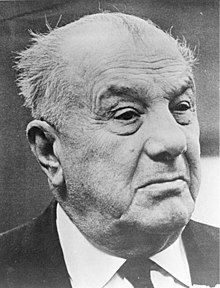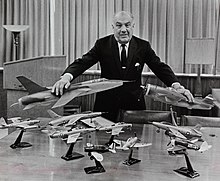Alexander Kartweli
Alexander Kartweli (Kartwelischwili) ( Georgian ალექსანდრე ქართველი Alexandre Kartveli ) (born September 9, 1896 in Tbilisi , Georgia , † June 20, 1974 in New York City ) was an American inventor and aircraft designer of Georgian origin. He is known, among other things, for the development of the Seversky P-35 and P-47 Thunderbolt , the first operational American jet-powered fighter aircraft F-84 Thunderjet , as well as the Republic F-105 and numerous other aircraft of various types, including concepts and prototypes for the Space travel.
Youth and Emigration
Alexander Kartweli was born on September 9, 1896 in Tbilisi into a royal Georgian family. He attended a high school in the same city and graduated there in 1914. He then decided to emigrate to France and graduated from the Paris Aviation School in 1922. Shortly thereafter, he began a career as a test pilot, before he was seriously injured in an accident that same year and had to give up that career. From 1922 to 1927 he worked for the aircraft manufacturer Louis Blériot and designed two light aircraft of the Bernard and Ferbois types . One of his aircraft set a world speed record in 1924. In 1927, the American millionaire Charles A. Levine showed an interest in Kartweli's skills and invited him to New York to work in his Atlantic Aircraft Corporation . In America in 1931 he met the Russian Alexander Procofieff De Seversky, who had also emigrated from Georgia, and worked as chief designer in his Seversky Cooperation (later renamed the Republic Aviation Company ).
Career
Worked in the Seversky Cooperation
Kartweli and Seversky worked together on designs for all-metal aircraft. The out of the SEV-3 - amphibian resulting Seversky P-35 was completed in 1935 for the first flight and was the first single-seat fighter aircraft of the US Air Force with a new, innovative design. The SEV-3 , designed by Kartweli in 1933 , was converted to the Seversky BT-8 trainer aircraft and quickly lost to the North American BT-9 . Because of this he designed a faster two-seat fighter, the SEV-2XP, based on the SEV-3 . In a comparison with single-seat aircraft carried out by the USAAC in 1936, the SEV-2XP won and was subsequently converted to a single-seater by order of Seversky. It was named P-35 and entered service in 1937.
Worked for the Republic Aviation Company
P-47 Thunderbolt
In 1939 Alexander De Seversky was removed from his own company and renamed the Republic Aviation Company. Based on the P-35 as well as the X P-43 /44 and XP-47 , the Republic P-47 was created under Kartweli's leadership as chief designer and vice president . The prototypes XP-44 and XP-47 developed in 1939 were a further development of the P-35. In 1940, however, in view of the war that had broken out in Europe, they were viewed as too inefficient in a potential aerial battle against German fighter planes, whereupon the company hastily presented a modified version, the XP-47A , which was also rejected by the USAAC. As a result, Alexander Kartweli conceived a completely new design, which was to be much larger and fully meet the requirements of the Air Force. He efficiently installed an eighteen- cylinder Pratt & Whitney R-2800 engine and an armored pilot's cabin in an aircraft that was very large for the time. Eight Browning M2 machine guns (four for each wing) were fitted into the new wing, which also had enough space for larger ammunition stores. The new aircraft, designated the XP-47B , took off for the first time on May 6, 1941 and, despite a few shortcomings, delivered impressive results. It then went into series production from 1942. More than 15,000 P-47s were manufactured in total and used by various countries through 1966.
F-84 Thunderjet / Thunderstreak
Kartweli was already working on a replacement for the P-47 in 1944. However, this should consist of a jet-powered aircraft. Initially, he tried to take the P-47 as a basic concept and install a jet engine. However, this idea failed. Instead, he designed an aircraft with a streamlined fuselage that was manned by an axial compressor jet engine and had thick, straight wings in which the fuel tanks were to be located. On September 11th of the same year, the USAAF announced their minimum requirements for an aircraft to be ready to put into service. Just a month later, Republic Aviation received an order for three prototypes of the new concept, known at the time as the XP-84 . Even before the first test flight, the American Air Force placed further orders in January 1945, including operational versions ( P-84B ). However, extended tests on the ground revealed serious shortcomings and Kartweli made numerous modifications and improvements. There were late deliveries to the Army as the XP-84 didn't take off for the first time until February 28, 1946. One problem was that the first P-84B - which were delivered before the actual test flight - also had to be modified afterwards. The upgraded XP-84 was equipped with a J35-A-15 engine, six Browning machine guns (four in the nose and one in the wings) and a total fuel capacity of 1,740 liters. The new F-84 fighter / fighter-bomber went into series production for the newly formed US Air Force from November 1947 . The F-84 was the first aircraft that could be refueled in the air and equipped with a Mark 7 atomic bomb. An expanded design was the Republic F-84F Thunderstreak , which had its wings pointing backwards. In total, more than 7,000 of these aircraft were manufactured and were used by various countries until 1991.
F-105 Thunderchief
To replace the F-84F Thunderstreak in its strategic role, the Republic Aviation design team, under Alexander Kartweli's leadership, came up with a new concept in 1951. The Republic F-105 was designed to penetrate enemy lines and drop atomic bombs thanks to its high speed and low flight. Good maneuverability was foregone. The aircraft was often used as a fighter-bomber during the Vietnam War . Although promising in its own role, it proved to be an easy target for Soviet interceptors and was also shot down on several occasions due to low-level flights from light anti-aircraft fire. In total, the United States lost up to 400 F-105s over Vietnam and Southeast Asia.
A-10 Thunderbolt II
Alexander Kartweli is awarded the participation or at least influence in the development of the A-10 Thunderbolt (Warthog), as he worked as a designer and consultant in the Fairchild Hiller company from 1964 until his death in 1974 . The name of the aircraft is based on the P-47 Thunderbolt that he had previously developed during World War II. The A-10 is an effective and widely used ground attack aircraft of the US Air Force, which has similar robust characteristics as Kartweli's designs for fighter-bombers.
More work
During his time at the Republic Aviation Company, Kartweli designed various concepts that were not or only partially implemented. This includes his contribution to the so-called Aerospace Plane ( bodied ) project from 1958 to 1963. He represented the concept of a by ramjet engines powered spacecraft, which the later space shuttle of NASA very similar.
Developed from 1949 to 1957, the Republic XF-103 - also known as the Weapon System WS-201A or Thunderwarrior - was a joint design by Alexander Kartwelis and William O'Donnels. It was intended as a Mach 3 capable high-speed interceptor against Soviet bombers. However, their development was stopped for reasons of cost and technical problems.
Another Kartweli design is the Republic XF-12 . It was supposed to act as a fast reconnaissance aircraft for impending bombing raids and as a flying photo laboratory. The order was placed by the USAAF in 1943 and a prototype of the XF-12 successfully completed its maiden flight in 1946, exceeding all expectations. However, it was already too late for a consistent production series, since by the time their development was completed there were already aircraft that could take over their tasks, which is why the project was discontinued in 1948.
Web links
Individual evidence
- ↑ a b Dennis R. Jenkins: Kartveli, Alexander (1896–1974). In: Air Warfare. An International Encyclopedia. Walter J. Boyne, 2002, p. 346 , accessed January 7, 2014 (English).
- ↑ a b Joseph Kastner: Kartveli. In: Life. October 5, 1942, pp. 60-66 , accessed January 7, 2014 (English).
- ↑ Roland C. Gask: The Thunderbolt. In: Flying. February 1945, pp. 34 , 134-135 , accessed January 7, 2014 (English).
- ↑ Corey C. Jordan: P-47 Thunderbolt: Aviation Darwinism, Chapter Two. In: The Cradle of Aviation Series: Seversky & Republic. Archived from the original on March 25, 2012 ; accessed on March 6, 2020 (English).
- ↑ Corey C. Jordan: P-47 Thunderbolt: Aviation Darwinism, Chapter Three. In: The Cradle of Aviation Series: Seversky & Republic. Archived from the original on December 27, 2013 ; accessed on March 6, 2020 (English).
- ↑ James K. Libbey: Alexander P. de Seversky and the Quest for Air Power. 2013, accessed January 7, 2014 .
- ↑ Fairchild Aircraft, Inc. referenceforbusiness.com, accessed January 7, 2014 (English).
- ^ Republic F-84 Thunderstreak / Thunderbird. Fiddlers Green, accessed January 7, 2014 .
- ↑ Kennedy Hickman: Vietnam War: F-105 Thunderchief. Retrieved January 7, 2014 .
- ^ Craig C. Hannah: Striving for Air Superiority: The Tactical Air Command in Vietnam. 2002, pp. 48–54 , accessed on January 7, 2014 (English).
- ↑ http://www.zoominfo.com/p/Alexander-Kartveli/89159325
- ↑ http://www.alexanderkartveli.com/a10/
- ↑ http://www.neam.org/index.php?option=com_content&view=article&id=98:republicp47d&catid=8:collection-items&Itemid=101
- ^ Republic RC-3 Seabee History. Steinar Saevdal, accessed January 7, 2014 ("Fortune" Magazine Article; "Experiment at Republic" February 1947).
- ^ Alexander Kartveli: Engineering Aspects of the Development of the Rainbow. 1946, accessed January 7, 2014 .
| personal data | |
|---|---|
| SURNAME | Kartweli, Alexander |
| ALTERNATIVE NAMES | Kartvelishvili, Alexander (full name); Kartveli, Alexandre; ალექსანდრე ქართველი (Georgian) |
| BRIEF DESCRIPTION | American-Georgian inventor and aircraft designer |
| DATE OF BIRTH | September 9, 1896 |
| PLACE OF BIRTH | Tbilisi , Georgia |
| DATE OF DEATH | June 20, 1974 |
| Place of death | New York City |

